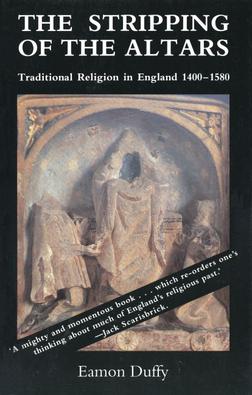The Stripping of the Altars facts for kids
 |
|
| Author | Eamon Duffy |
|---|---|
| Country | United Kingdom |
| Language | English |
| Subject | English Reformation Roman Catholicism in Great Britain |
| Publisher | Yale University Press |
|
Publication date
|
1992 |
| Media type | Print (hardback & paperback) |
| Pages | 654 |
| ISBN | 0-300-06076-9 (paperback) |
The Stripping of the Altars: Traditional Religion in England, 1400–1580 is a history book written by Eamon Duffy. It was published in 1992 by Yale University Press. The book won an important award called the Longman-History Today Book of the Year Award. This book explores how people in England practiced their religion, especially the Roman Catholic faith, before and during the English Reformation. It looks at the changes that happened between 1400 and 1580.
Contents
What the Book is About
This book by Eamon Duffy looks closely at religious life in England before the English Reformation. It focuses on the time between 1400 and 1580. Duffy wanted to show how popular and strong traditional religious beliefs were back then.
Before the 1980s, many historians thought the English Church was corrupt. They believed it needed big changes, which led to the Reformation. This idea was sometimes called "the Whig version" of history. A historian named A. G. Dickens wrote a popular book in 1964 that shared this view.
Duffy's main idea is different. He argues that the Roman Catholic faith in England was actually very strong and lively before the Reformation. He believes it was not dying out or weak. His book challenges the older idea that the Catholic Church was failing to meet people's spiritual needs.
How People Practiced Religion
Duffy uses many different kinds of old records and items to make his point. He looks at things like old financial accounts, wills, prayer books, and even stained glass windows. He also studies old jokes and graffiti.
From all this evidence, Duffy suggests that religious life before the Reformation was very sincere. People were deeply religious and took part in many activities. He shows how the church calendar, with its special fasts and festivals, shaped how people saw their world.
Duffy argues that Catholicism was popular with everyone. Both rich nobles and poor farmers practiced it. He also points out that there was no big difference in how the clergy (church leaders) and ordinary people practiced their faith. Everyone was part of one big religious community.
Changes During the Reformation
The second part of Duffy's book describes how Protestantism was quickly brought into England in the mid-1500s. It shows how society reacted to the religious changes made by kings and queens like Henry VIII, Edward VI, and Elizabeth I.
Duffy finds many records that show how religious practices changed. These changes were huge for English religious life. It was a difficult time for Catholics, who felt confused and upset. They lost many familiar ways of worshiping.
Duffy also talks about the brief hope Catholics felt when Queen Mary I ruled from 1553 to 1558. She was Catholic and tried to bring back the old ways. But this hope ended quickly when Mary died. Duffy's book shows how centuries of religious traditions disappeared because of strong control from the government.
Why This Book is Important
Historians like David Siegenthaler have said this book is important. It helps us understand the religious lives of people in England before and after the split from the Roman Catholic Church. It allows us to appreciate their religious practices.
Duffy's book suggests that the Catholic Church before the Reformation was not as bad as some historians thought. He also questions if the reformers really improved a dying church. If Duffy's ideas are correct, his book changes how we see a big part of English history.
The book has been updated several times. A second edition came out in 2005, and a third in 2022. In these new editions, Duffy shares more thoughts and responds to some of the discussions about his book.

